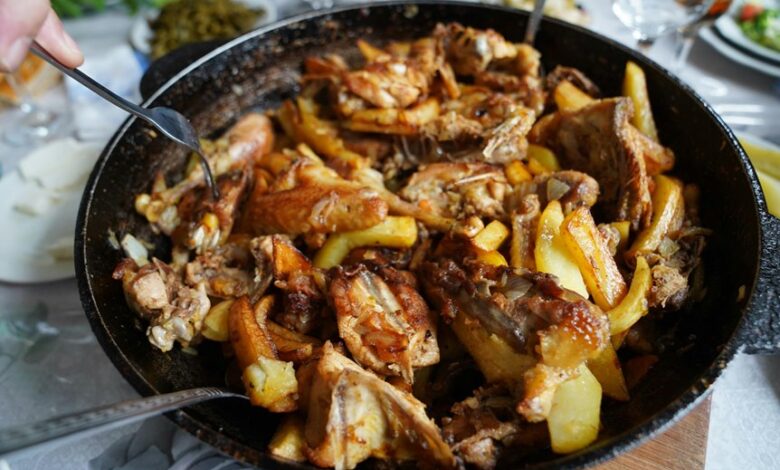Define Picadillo: Everything You Need to Know About This Dish

Picadillo is a dish steeped in history and cultural significance. Its origins can be traced back to Spanish cuisine, evolving into a beloved staple across Latin America, particularly in Cuba. This hearty meal typically combines ground meat with a medley of vegetables and spices, reflecting diverse regional influences. Understanding picadillo goes beyond mere ingredients; it encapsulates stories of heritage and community. What makes this dish so special, and how do its variations tell a deeper tale?
The Origins of Picadillo
Picadillo, a flavorful dish steeped in history, traces its origins to Spain, where it was traditionally made with minced meat and a variety of spices.
As it journeyed to Latin America, particularly Cuba, it evolved, reflecting the complexities of Cuban history.
Influences from Mexican cuisine also shaped its development, showcasing a rich tapestry of cultural fusion that enchants the taste buds.
Key Ingredients and Variations
Picadillo, a flavorful staple in Latin cuisine, is characterized by its essential components such as ground meat, tomatoes, onions, and a medley of spices.
However, this dish is far from uniform; regional variations introduce unique ingredients like olives, raisins, or bell peppers, reflecting local tastes and traditions.
Understanding these key elements and adaptations reveals the rich tapestry of picadillo’s cultural significance across different communities.
Essential Components of Picadillo
At the heart of this beloved dish lies a harmonious blend of essential components that define its unique flavor profile.
Traditionally, picadillo features ground meat choices, such as beef or pork, combined with tomatoes, onions, and bell peppers.
Spice levels can vary, allowing for personal preference, while olives and raisins add depth.
This combination creates a satisfying dish that resonates with culinary freedom and creativity.
Regional Variations Explained
While picadillo may share common roots, its regional variations showcase a delightful array of ingredients and preparations that reflect local tastes and cultural influences.
In Mexico, traditional ingredients like olives and almonds create a unique flavor, while in Cuba, raisins and capers add sweetness and tang.
These cultural interpretations highlight the versatility of picadillo, transforming it into a beloved dish across diverse culinary landscapes.
Cooking Techniques for Perfect Picadillo
Achieving the perfect picadillo involves mastering a few essential cooking techniques that elevate this traditional dish to new heights.
Key cooking methods include browning the meat for depth and sautéing vegetables to unlock their natural sweetness.
Incorporating spices and herbs at the right moment ensures flavor enhancement, creating a harmonious blend that captivates the palate.
Attention to these details transforms picadillo into a culinary masterpiece.
Regional Differences in Picadillo Recipes
Picadillo is a dish that showcases remarkable regional variations, each reflecting the unique culinary traditions and local ingredients of its origin.
Hispanic variations abound, from the sweet and savory Cuban version with raisins and olives to the spicier Mexican adaptations featuring potatoes and jalapeños.
These diverse interpretations highlight the dish’s versatility, allowing it to evolve while remaining a beloved comfort food across cultures.
Cultural Significance of Picadillo
The cultural significance of picadillo extends far beyond its role as a comforting meal; it serves as a culinary symbol of heritage and identity in many Latin American countries.
Its diverse variations reflect regional cultural influences and historical significance, illustrating the rich tapestry of traditions and stories associated with each preparation.
Picadillo connects generations, embodying the essence of community and shared culinary experiences.
Tips for Serving and Pairing Picadillo
When serving picadillo, thoughtful accompaniments can elevate the dish’s rich flavors, making it a satisfying meal.
Pairing it with the right beverages enhances the dining experience, while serving it at an optimal temperature ensures each bite is enjoyed to the fullest.
Exploring these elements can transform a simple meal into a memorable culinary occasion.
Best Accompaniments for Picadillo
A vibrant plate of picadillo can be elevated with the right accompaniments, transforming a simple meal into a delightful culinary experience.
The best side dishes include fluffy white rice or fried plantains, which complement the dish’s rich flavors.
Perfect toppings such as fresh cilantro, diced avocado, or a squeeze of lime add brightness, enhancing the overall taste and ensuring a memorable dining experience.
Ideal Beverage Pairings
Elevating the experience of enjoying picadillo goes beyond just the dish itself; the right beverage pairings can enhance its rich and complex flavors.
For delightful beverage suggestions, consider a medium-bodied red wine, such as a Tempranillo or Malbec, which complements the dish’s spices.
Alternatively, a refreshing mojito or a crisp lager can balance the hearty taste, offering a unique twist to the meal.
Serving Temperature Recommendations
To fully appreciate the flavors of picadillo, serving temperature plays a crucial role in enhancing the dining experience. Ideally, picadillo should be served warm, allowing its rich aroma and spices to shine. Additionally, incorporating vibrant garnishes can elevate its presentation.
| Serving Temperature | Presentation Tips |
|---|---|
| Warm | Garnish with cilantro |
| Room Temperature | Serve with lime wedges |
| Hot | Accompany with rice |
Conclusion
In conclusion, picadillo is a culinary tapestry woven from diverse cultural threads, much like a vibrant quilt that tells the stories of its origins. This dish, with its rich flavors and unique regional variations, not only satisfies the palate but also nourishes the spirit, bridging generations and traditions. Whether served at a family gathering or a festive celebration, picadillo remains a beloved staple, inviting all to partake in its delicious legacy and shared history.




